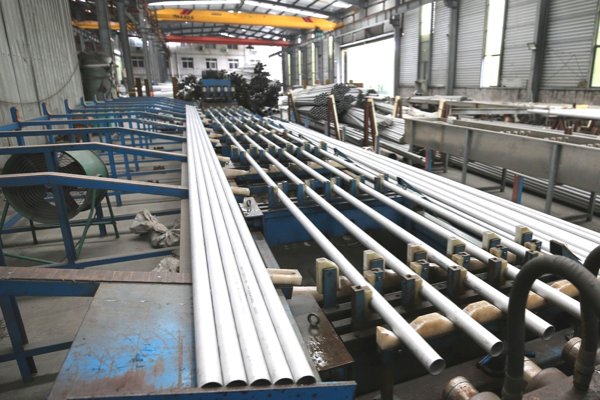close
Choose Your Site
Global
Social Media
If you’ve ever dealt with cutting Stainless Steel Pipe, you know that doing it without kinking or deforming the pipe can be tricky. Whether you’re a DIY enthusiast or a professional plumber, knowing how to correctly cut stainless steel pipes ensures a clean job and prevents costly mistakes. This guide will walk you through the process, tools, and techniques needed to achieve precise, kink-free cuts every time.
A Stainless Steel Pipe is highly valued in construction, plumbing, and various industries due to its strength, resistance to corrosion, and ease of maintenance. Pipes like 304 stainless steel pipe, Austenitic Stainless Steel Pipes, and Duplex Stainless Steel Pipe are popular for their exceptional durability, reliability, and compatibility with different industrial environments.
At Xintongda Special Steel, a leading stainless steel pipe supplier, stainless steel pipes are manufactured to international standards, making them suitable for challenging environments such as oil refineries, power stations, and chemical plants.
Cutting a Stainless Steel Pipe improperly can result in:
Kinking: Causes poor fitting and potential leaks.
Uneven edges: Makes connecting fittings challenging.
Heat distortion: Weakens the pipe structure.
Using proper tools, such as a specialized stainless steel pipe cutter, reduces these risks significantly.
To ensure a clean, kink-free cut, it's important to choose the right tools:
Stainless Steel Pipe Cutter: Designed specifically for pipes, ensures precision and consistency.
Angle Grinder: Quick cutting but requires experience to prevent overheating and deformation.
Band Saw: Ideal for thicker pipes; provides controlled, straight cuts.
Hacksaw: Budget-friendly and suitable for smaller, thinner pipes but labor-intensive.
Xintongda, as a trusted stainless steel pipe supplier, advises using professional-grade tools to maintain pipe integrity.
Here’s a straightforward process to cut Stainless Steel Pipe perfectly:
Measure your pipe carefully. If you're working with standardized pipe sizes, such as a 2 inch stainless steel pipe or stainless steel pipe sch 40, accuracy is key to avoiding mistakes.
Clearly mark your cutting line around the pipe. Firmly secure the pipe using clamps or a vise to ensure stability during cutting.
For thinner pipes or delicate fittings, a specialized stainless steel pipe cutter is ideal. Larger diameter pipes, available at a stainless steel pipe factory, often require industrial tools like band saws or angle grinders.
Begin cutting slowly. Too fast, and you risk heating the metal excessively. If using an angle grinder or band saw, apply gentle, consistent pressure, allowing the blade or wheel to do the work without forcing it.
After the cut, use a deburring tool or a file to smooth out rough edges. This step prevents damage when connecting stainless steel pipe fittings and stainless steel pipe connectors.
Choosing the right Stainless Steel Pipe type depends on your project needs. Here's a quick overview of common types:
304 Stainless Steel Pipe: Highly corrosion-resistant and suitable for general plumbing, chemical handling, and food processing.
Corrugated Stainless Steel Pipe: Ideal for gas and liquid transportation; offers flexibility and ease of installation.
Duplex Stainless Steel Pipe: Exceptional strength and corrosion resistance, perfect for demanding industrial conditions like chemical plants or marine environments.

| Pipe Type | Corrosion Resistance | Strength | Typical Applications |
|---|---|---|---|
| 304 Stainless Steel Pipe | Excellent | Good | Plumbing, food industry, HVAC |
| Duplex Stainless Steel Pipe | Outstanding | Excellent | Oil & gas, marine, chemical plants |
| Corrugated Stainless Steel Pipe | Good | Moderate | Gas piping, residential applications |
The above comparison can guide you when consulting a stainless steel pipe supplier or visiting a stainless steel pipe factory for bulk orders.
When looking for "stainless steel pipe near me," you'll find both local suppliers and imports. Imported products, especially those from a stainless steel pipe factory in China, like Xintongda, typically offer competitive pricing and high-quality standards due to strict production certifications like PED, ISO9001, and AD2000.
Local suppliers, on the other hand, offer faster availability and customer support but might come at a higher cost. Balancing your project's urgency and budget helps in making an informed decision.
Q1: Can I use a regular saw to cut Stainless Steel Pipe?
A1: Yes, but a specialized stainless steel pipe cutter or a metal-specific blade on a hacksaw or band saw will yield cleaner and more precise results.
Q2: Where can I find high-quality Stainless Steel Pipe suppliers?
A2: For bulk purchasing or high-quality standards, suppliers like Xintongda (stainless steel pipe china) are recommended due to their extensive certifications and rigorous quality checks.
Q3: What pipe size is most common in home plumbing?
A3: The 2 inch stainless steel pipe is commonly used in home plumbing for efficient water and waste transportation.
Q4: Is it necessary to deburr the pipe after cutting?
A4: Yes, deburring prevents damage to stainless steel pipe fittings and ensures safe handling and optimal performance.
Q5: Are corrugated stainless steel pipes safe for gas lines?
A5: Absolutely. Corrugated stainless steel pipe is widely accepted for gas lines due to its flexibility and strong resistance to leaks.
To maintain your Stainless Steel Pipe system effectively:
Regularly inspect connections, especially stainless steel pipe connectors and fittings.
Check for signs of corrosion, particularly at joints or bends.
Clean pipes periodically using mild detergents to avoid buildup or contamination.
Proper maintenance ensures longevity and optimal performance of your stainless steel pipes.
Xintongda is a renowned stainless steel pipe supplier and stainless steel pipe factory, committed to delivering high-quality products such as Austenitic Stainless Steel Pipes, Duplex Stainless Steel Pipes, and various fittings like flanges and valves. With state-of-the-art production facilities, the company provides tailored solutions for industries ranging from petrochemical to nuclear power, ensuring reliability under the harshest conditions.
Cutting stainless steel pipes without kinking isn't complicated—just follow the right methods and use proper tools. Trusting reliable suppliers like Xintongda further ensures quality and project success, no matter the size or complexity.